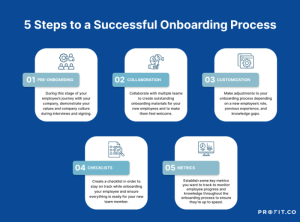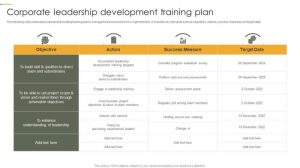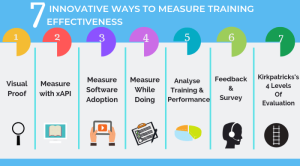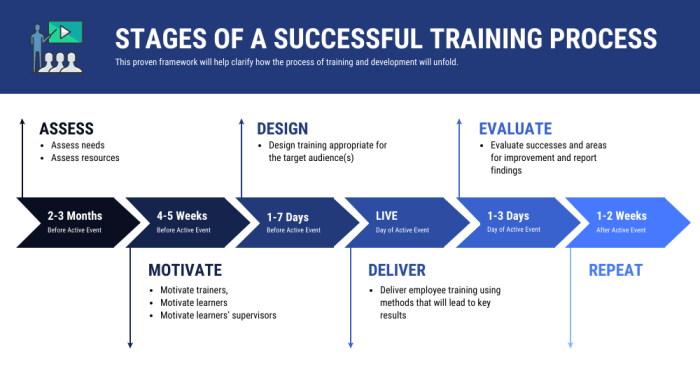
Investing in employee skill development through corporate training isn’t just a cost; it’s a strategic investment yielding significant returns. From enhancing individual performance to driving organizational growth, effective training programs foster a culture of continuous learning and innovation. This exploration delves into the multifaceted aspects of designing, implementing, and measuring the success of such initiatives, examining various training methodologies, technological integrations, and crucial budgeting considerations.
This examination covers a wide spectrum, from defining employee skill development and exploring diverse training program formats (online courses, workshops, mentoring, etc.) to measuring training effectiveness using key performance indicators (KPIs) and analyzing data for improvement. We’ll also address the critical role of technology in modern training delivery, exploring challenges and opportunities related to its integration, and finally, establishing a clear link between robust corporate training and overall corporate growth.
Defining Employee Skill Development
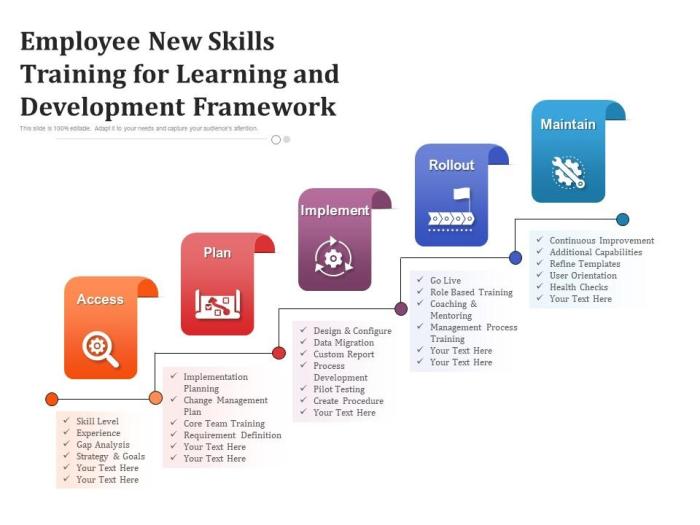
Employee skill development, within the context of corporate training, is a strategic process focused on enhancing the capabilities and knowledge of employees to improve individual and organizational performance. It encompasses a multifaceted approach, going beyond simply imparting information to fostering practical application and continuous growth. This development is crucial for adapting to evolving industry demands, enhancing productivity, and driving innovation.Employee skill development programs aim to cultivate a wide array of skills, categorized broadly into several key areas.
These programs are designed to address both the current and future needs of the organization and its employees.
Types of Skills Developed Through Corporate Training
Corporate training programs address a diverse range of skills, ensuring employees are equipped for current roles and future challenges. These skill categories are often interconnected and mutually reinforcing. For instance, strong technical skills are often enhanced by effective communication (a soft skill).
Benefits of Investing in Employee Skill Development Programs
Investing in employee skill development yields significant returns for both the individual employee and the organization. These benefits extend beyond immediate productivity gains to encompass long-term growth and competitiveness. The return on investment (ROI) can be substantial, impacting various aspects of the business.
Return on Investment (ROI) of Different Training Methodologies
The ROI of training varies depending on the methodology employed. Factors such as program design, delivery method, and participant engagement all influence the effectiveness and resulting return. While precise figures are difficult to generalize due to varying contexts, the table below offers a comparative overview. It’s important to note that these are illustrative examples and actual ROI can fluctuate based on several factors.
| Training Methodology | Estimated ROI (Percentage) | Strengths | Limitations |
|---|---|---|---|
| On-the-Job Training | 30-50% | Cost-effective, practical application, immediate feedback | Inconsistent quality, potential for bad habits, limited scalability |
| E-learning | 25-40% | Flexible, accessible, cost-effective for large groups | Requires self-discipline, less interaction, potential for low engagement |
| Instructor-led Training | 40-60% | High engagement, immediate feedback, personalized learning | Expensive, less flexible scheduling, limited scalability |
| Mentorship/Coaching | 50-70% | Personalized development, strong relationship building, long-term impact | Time-consuming, requires careful matching of mentors and mentees, scalability challenges |
Types of Corporate Training Programs
Effective employee skill development hinges on the selection and implementation of appropriate corporate training programs. The right program can significantly boost productivity, improve employee morale, and enhance overall organizational performance. A variety of formats exist, each with its own strengths and weaknesses, making careful consideration crucial for optimal results.
Organizations utilize diverse training program formats to cater to different learning styles and developmental needs. The choice of method often depends on factors such as budget, employee availability, the complexity of the subject matter, and the desired learning outcomes. Understanding the nuances of each approach allows for strategic program selection, maximizing return on investment (ROI) and fostering a culture of continuous learning.
Corporate Training Program Formats
Several formats exist for delivering corporate training, each offering unique advantages and disadvantages. Choosing the right format is key to successful employee development.
- Online Courses: These self-paced programs offer flexibility and accessibility, allowing employees to learn at their own convenience. They often incorporate interactive elements, videos, and assessments to enhance engagement. However, they can lack the immediate feedback and interaction of other methods.
- Workshops: These interactive sessions provide a collaborative learning environment, fostering peer-to-peer learning and immediate feedback from instructors. They are ideal for hands-on training and skill development in specific areas. However, they require dedicated time and resources, and their effectiveness can depend on the facilitator’s skill.
- Mentoring: This approach pairs experienced employees with less experienced colleagues, providing personalized guidance and support. It fosters strong relationships and allows for the transfer of tacit knowledge. However, it requires careful selection of mentors and mentees and can be time-consuming.
- On-the-Job Training: This practical approach involves learning by doing, under the supervision of an experienced colleague. It allows for immediate application of learned skills and provides realistic context. However, it can be inconsistent in quality and may not provide structured learning.
- Simulations: These immersive experiences allow employees to practice skills in a safe, risk-free environment. They are particularly useful for high-stakes situations, such as crisis management or complex equipment operation. However, they can be expensive to develop and may not fully replicate real-world scenarios.
Comparison of Training Delivery Methods Effectiveness
The effectiveness of different training delivery methods varies depending on several factors. A balanced approach often yields the best results.
- Online Courses vs. Workshops: Online courses offer flexibility but may lack the engagement of workshops. Workshops provide immediate feedback and interaction but require dedicated time and resources.
- Mentoring vs. On-the-Job Training: Mentoring provides personalized guidance, while on-the-job training offers practical experience. Both approaches benefit from structured learning components to ensure consistency and effectiveness.
- Simulations vs. Other Methods: Simulations offer a safe environment for practicing high-stakes skills, but they may not fully replicate real-world complexities. Combining simulations with other methods can enhance learning and retention.
Factors to Consider When Selecting Training Programs
Choosing the right training program requires a careful assessment of various factors, ensuring alignment with organizational goals and employee needs at different levels.
- Employee Level: Entry-level employees may benefit from structured on-the-job training and online courses, while senior employees may benefit more from mentoring and workshops focusing on leadership development or specialized skills.
- Learning Objectives: Clearly defined learning objectives are essential for selecting the most appropriate training method. For example, developing technical skills might necessitate hands-on training or simulations, while improving communication skills might benefit from workshops or mentoring.
- Budget and Resources: The cost of different training methods varies significantly. Online courses are generally more cost-effective than workshops or simulations. Organizations need to balance cost with effectiveness when making decisions.
- Employee Preferences and Learning Styles: Considering employee preferences and learning styles is crucial for maximizing engagement and knowledge retention. Some employees may prefer self-paced online learning, while others may thrive in interactive workshop settings.
- Accessibility and Availability: The chosen training method must be accessible to all employees, considering factors such as geographical location, technology access, and time constraints. A blended approach, combining online and in-person training, can often overcome these challenges.
Measuring the Effectiveness of Training Programs

Effective training programs are crucial for organizational success, but their impact needs careful evaluation. Measuring the effectiveness of these initiatives allows organizations to understand the return on investment (ROI) and identify areas for improvement. This involves employing various methods to assess both the immediate and long-term effects of training on employee skills and overall organizational performance.
Methods for Evaluating Training Program Effectiveness
Several methods can be used to gauge the success of employee skill development programs. These methods offer a comprehensive approach, encompassing participant feedback, skill demonstration, and observable changes in performance. A multi-faceted approach is key to gaining a truly accurate picture.
- Kirkpatrick’s Four Levels of Evaluation: This model provides a structured framework. Level 1 assesses reaction (how participants felt about the training); Level 2 measures learning (knowledge and skill acquisition); Level 3 evaluates behavior (changes in on-the-job performance); and Level 4 examines results (impact on organizational goals).
- Pre- and Post-Training Assessments: These tests, using standardized instruments, compare employee skills and knowledge before and after training. The improvement reflects the effectiveness of the program in imparting knowledge and skills.
- Performance-Based Assessments: These assessments directly evaluate the application of learned skills in real-world scenarios. Examples include simulations, role-playing exercises, or on-the-job observations.
- 360-Degree Feedback: This method gathers feedback from supervisors, peers, and subordinates, providing a holistic view of an employee’s performance changes after training.
- Return on Investment (ROI) Analysis: This method quantifies the financial benefits of training, considering factors like training costs, increased productivity, reduced errors, and improved employee retention.
Employee Satisfaction and Skill Improvement Survey
A well-designed survey can effectively capture employee feedback regarding training effectiveness. The following questionnaire provides a template, adaptable to specific training programs.
Employee Training Feedback Survey
| Question | Response Options |
|---|---|
| How satisfied were you with the overall training program? | Very Satisfied, Satisfied, Neutral, Dissatisfied, Very Dissatisfied |
| How well did the training meet your expectations? | Exceeded Expectations, Met Expectations, Did Not Meet Expectations |
| Rate the clarity and effectiveness of the training materials. | Excellent, Good, Fair, Poor |
| Rate the instructor’s ability to engage and motivate participants. | Excellent, Good, Fair, Poor |
| How much did you learn from this training program? | A Great Deal, A Moderate Amount, A Little, Nothing |
| How confident are you in your ability to apply what you learned on the job? | Very Confident, Confident, Somewhat Confident, Not Confident |
| What aspects of the training were most beneficial? | Open-ended text box |
| What aspects of the training could be improved? | Open-ended text box |
Metrics for Measuring Training Impact
Measuring the impact of training requires tracking relevant Key Performance Indicators (KPIs). These KPIs can be used to assess both individual and organizational-level improvements.
- Individual Performance Metrics: Increased productivity, improved quality of work, reduced errors, faster task completion times, improved customer satisfaction scores (if applicable).
- Organizational-Level Metrics: Reduced employee turnover, increased sales or revenue, improved efficiency, enhanced customer satisfaction, better employee engagement scores.
Examples of KPIs include: a reduction in customer complaints after customer service training, an increase in sales following a sales training program, or an improvement in employee retention rates after leadership development training.
Analyzing Training Data to Identify Areas for Improvement
Analyzing data gathered from various evaluation methods allows for identifying areas needing improvement. This involves comparing pre- and post-training assessment results, analyzing survey feedback, and reviewing performance data. For instance, consistently low scores on a specific section of a post-training assessment might indicate a need to revise that section of the training material. Similarly, negative feedback regarding an instructor’s teaching style may require adjustments to the training delivery method.
By systematically analyzing this data, organizations can refine their training programs to maximize their effectiveness.
The Role of Technology in Corporate Training
Technology has revolutionized corporate training, offering innovative ways to deliver, manage, and track employee skill development. The integration of technology not only enhances the learning experience but also streamlines administrative tasks and provides valuable data for evaluating training effectiveness. This section will explore the impact of various technologies on corporate training programs and provide a practical guide to their implementation.Technology significantly improves the efficiency and effectiveness of corporate training programs.
Learning Management Systems (LMS) provide a centralized platform for course delivery, tracking progress, and managing training materials. Virtual Reality (VR) offers immersive learning experiences, simulating real-world scenarios for improved knowledge retention. Mobile learning allows for flexible and accessible training anytime, anywhere, catering to the diverse needs and schedules of today’s workforce.
Learning Management Systems (LMS) in Corporate Training
LMS platforms are the backbone of many modern corporate training programs. They provide a centralized repository for all training materials, allowing employees to access courses at their convenience. Features such as progress tracking, automated reminders, and integrated assessment tools ensure effective learning and efficient administration. Popular LMS platforms offer features like personalized learning paths, gamification elements, and social learning tools, fostering engagement and collaboration among learners.
For example, a company could use an LMS to deliver compliance training, onboarding modules, or specialized skill development courses, tracking completion rates and identifying areas needing improvement.
Virtual Reality (VR) in Corporate Training
VR technology offers an immersive and engaging learning environment. By simulating real-world scenarios, VR training can significantly improve knowledge retention and skill development, particularly in areas requiring hands-on experience. For instance, a manufacturing company could use VR to train employees on operating complex machinery, minimizing the risk of errors and accidents during on-the-job training. Similarly, healthcare professionals could utilize VR simulations to practice complex procedures in a safe and controlled environment before performing them on actual patients.
The cost of VR equipment and the need for specialized content development are factors to consider.
Mobile Learning in Corporate Training
Mobile learning leverages smartphones and tablets to deliver training content anytime, anywhere. This flexibility is particularly beneficial for employees with busy schedules or those working remotely. Microlearning, which delivers bite-sized learning modules, is well-suited for mobile devices, making it easy for employees to integrate training into their daily routines. Examples include short video tutorials, interactive quizzes, and quick reference guides accessible through mobile apps.
The accessibility and convenience of mobile learning contribute to increased employee engagement and knowledge retention.
Implementing a New Technology-Based Training Program: A Step-by-Step Guide
Implementing a new technology-based training program requires careful planning and execution. The following steps provide a framework for successful implementation:
- Needs Assessment: Identify specific training needs and learning objectives. Analyze current training methods and identify areas for improvement.
- Technology Selection: Choose appropriate technology based on training needs, budget, and employee technical skills. Consider LMS, VR, mobile learning, or a combination.
- Content Development: Create engaging and effective training materials tailored to the chosen technology. Ensure accessibility and compatibility across devices.
- Pilot Program: Test the program with a small group of employees to identify and address any issues before full-scale deployment.
- Training and Support: Provide adequate training and ongoing support to employees on using the new technology and accessing training materials.
- Evaluation and Improvement: Continuously monitor and evaluate the program’s effectiveness, making adjustments as needed based on feedback and performance data.
Challenges and Opportunities of Integrating Technology into Employee Skill Development
Integrating technology into employee skill development presents both challenges and opportunities. Challenges include the initial investment costs of technology and training, the need for technical expertise, and the potential for digital divides among employees with varying levels of technological proficiency. Opportunities include improved learning outcomes, increased employee engagement, reduced training costs in the long run due to automation and scalability, and the ability to track and measure training effectiveness more accurately.
Successful integration requires careful planning, effective communication, and ongoing support to address potential challenges and maximize the benefits of technology.
Corporate Growth and Corporate Training
Investing in employee skill development through robust corporate training programs isn’t merely a cost; it’s a strategic investment directly linked to a company’s overall growth and success. A highly skilled and adaptable workforce is the cornerstone of a thriving organization, capable of navigating challenges and capitalizing on opportunities in a rapidly changing business landscape.A direct correlation exists between effective corporate training and key performance indicators (KPIs) like increased productivity, innovation, and profitability.
When employees possess the necessary skills and knowledge, they perform their tasks more efficiently, leading to higher output and improved quality. Furthermore, continuous learning fosters a culture of innovation, empowering employees to develop creative solutions and drive business growth. This ultimately translates into improved profitability, as a more efficient and innovative workforce generates higher returns on investment.
Examples of Successful Employee Skill Development Initiatives
The following table showcases how successful employee skill development initiatives have demonstrably contributed to increased productivity, innovation, and profitability within various organizations. These examples highlight the tangible benefits of investing in corporate training.
| Company | Training Initiative | Impact on Productivity | Impact on Innovation/Profitability |
|---|---|---|---|
| Salesforce | Comprehensive sales training programs focusing on customer relationship management (CRM) and sales methodologies. | Increased sales conversion rates by 15%, leading to significant revenue growth. | Improved customer satisfaction scores and increased customer lifetime value, resulting in enhanced profitability. |
| Extensive internal training programs on data analysis, machine learning, and software development. | Improved efficiency in product development cycles and faster deployment of new features. | Development of innovative products and services, leading to market leadership and increased revenue streams. | |
| Microsoft | Leadership development programs focused on strategic thinking, communication, and team management. | Enhanced team collaboration and improved project execution, resulting in on-time and within-budget project delivery. | Increased employee engagement and retention, leading to a more stable and productive workforce. |
| Amazon | Continuous training programs focused on logistics, supply chain management, and customer service. | Optimized warehouse operations and improved order fulfillment times, leading to increased customer satisfaction. | Reduced operational costs and increased efficiency across the entire supply chain, resulting in higher profit margins. |
Aligning Corporate Training with Business Goals
To maximize the impact of corporate training, a strategic plan is crucial to align training initiatives with the overall business goals for growth. This plan should involve a systematic process encompassing needs assessment, program design, implementation, and evaluation.A successful alignment strategy involves the following steps:
1. Conducting a thorough needs assessment
Identifying skill gaps and training needs through surveys, interviews, and performance reviews. This ensures that training programs directly address the organization’s specific requirements.
2. Defining clear learning objectives
Establishing measurable goals for each training program, ensuring that they directly contribute to achieving business objectives. For example, a sales training program might aim to increase sales conversion rates by a specific percentage.
3. Developing a comprehensive training curriculum
Designing training programs that use a variety of learning methods, including online courses, workshops, and on-the-job training, to cater to different learning styles and preferences.
4. Implementing a robust training delivery system
Utilizing technology and effective instructional design principles to deliver engaging and effective training experiences. This includes leveraging learning management systems (LMS) to track progress and assess effectiveness.
5. Evaluating the effectiveness of training programs
Regularly assessing the impact of training programs on employee performance and business outcomes. This data is crucial for making adjustments and ensuring that training investments are yielding the desired results. Metrics like increased productivity, improved employee satisfaction, and enhanced profitability should be tracked and analyzed.
Challenges and Best Practices in Corporate Training
Implementing effective corporate training programs is crucial for organizational success, yet organizations often face significant hurdles. These challenges, if not properly addressed, can undermine the effectiveness of training initiatives and hinder employee skill development. Understanding these obstacles and adopting best practices is essential for maximizing the return on investment in training.Successful corporate training hinges on more than just designing engaging programs; it requires a strategic approach that considers the practical realities of implementation and the organizational culture.
Overcoming the challenges requires a proactive and multi-faceted strategy focusing on employee engagement, resource allocation, and leadership support.
Common Challenges in Corporate Training Implementation
Organizations frequently encounter several key challenges when implementing corporate training programs. These challenges often stem from a combination of logistical, resource-related, and cultural factors. Addressing these challenges requires a carefully planned and executed strategy.
- Resistance to Change: Employees may resist new training methods or skills due to fear of the unknown, discomfort with new technologies, or perceived irrelevance to their current roles. This resistance can manifest as disengagement during training sessions or a failure to apply newly acquired skills in the workplace.
- Lack of Time: Busy work schedules often leave little time for employees to dedicate to training, leading to rushed sessions, incomplete learning, and a lack of opportunity for practice and reinforcement. This can be especially problematic in organizations with high workloads and limited staffing.
- Inadequate Resources: Effective training requires sufficient resources, including funding for training materials, technology, instructor fees, and dedicated training space. A lack of these resources can lead to poorly designed programs, inadequate instructor support, and ultimately, ineffective training.
- Lack of Management Support: Without strong leadership buy-in and support, training initiatives can struggle to gain traction. Managers who don’t prioritize training or fail to reinforce its importance in the workplace can inadvertently undermine the entire process.
- Measuring Training Effectiveness: Determining whether training has actually improved employee skills and performance can be difficult. Without clear metrics and evaluation methods, it’s challenging to demonstrate the return on investment in training programs and make necessary adjustments.
Best Practices for Overcoming Challenges and Ensuring Training Success
To maximize the effectiveness of corporate training, organizations should adopt several best practices. These practices focus on addressing the common challenges Artikeld above and fostering a culture of continuous learning.
- Secure Leadership Buy-in: Gaining support from senior management is crucial for resource allocation and establishing training as a strategic organizational priority. This ensures that training is viewed as an investment, not an expense.
- Needs Assessment: Conduct thorough needs assessments to identify specific skill gaps and tailor training programs to address those gaps directly. This ensures that training is relevant and valuable to employees.
- Microlearning and Flexible Delivery: Offer training in short, focused modules (microlearning) and through various methods (online, in-person, blended learning) to accommodate busy schedules and diverse learning styles. This allows for more convenient and accessible training.
- Gamification and Engaging Content: Incorporate game mechanics and interactive elements into training to increase engagement and knowledge retention. This makes the learning process more enjoyable and effective.
- Effective Evaluation and Feedback: Implement robust evaluation methods (pre- and post-training assessments, performance evaluations) to measure the effectiveness of training and gather feedback for improvement. This allows for continuous improvement of training programs.
- Reinforcement and Application: Provide opportunities for employees to apply their newly acquired skills in the workplace through on-the-job projects, mentoring, or coaching. This reinforces learning and ensures transfer of knowledge.
- Invest in Technology: Leverage learning management systems (LMS) and other technologies to streamline training delivery, track progress, and provide personalized learning experiences. This increases efficiency and effectiveness of training delivery.
Creating a Culture of Continuous Learning and Development
A culture of continuous learning is essential for organizational agility and long-term success. It fosters a mindset where employees are actively seeking opportunities to improve their skills and knowledge, leading to increased innovation, productivity, and employee satisfaction. This is not a one-time initiative but an ongoing commitment from leadership and employees alike. This culture is built through consistent reinforcement of learning opportunities, open communication, and clear demonstration of the value placed on employee growth.
Examples of fostering this culture include regular skill-building workshops, mentorship programs, access to online learning resources, and opportunities for employees to share their knowledge and expertise with colleagues. This creates a collaborative and supportive environment where learning is valued and actively encouraged.
Ultimately, successful employee skill development through corporate training hinges on a strategic alignment of training objectives with broader business goals. By thoughtfully designing programs, leveraging technology effectively, meticulously measuring impact, and fostering a culture of continuous learning, organizations can unlock the full potential of their workforce, driving increased productivity, innovation, and profitability. The journey towards a highly skilled and engaged workforce is an ongoing process requiring consistent evaluation and adaptation, ensuring that training initiatives remain relevant and impactful in a dynamic business environment.
Quick FAQs
What if employees resist participating in training?
Address resistance through clear communication highlighting the benefits, offering flexible training options, and recognizing and rewarding participation. Addressing underlying concerns and making the training relevant to their roles is crucial.
How can we ensure training stays relevant to changing business needs?
Regularly review and update training content based on industry trends, technological advancements, and evolving business strategies. Gather feedback from employees and stakeholders to identify skill gaps and adjust training accordingly.
How do we measure the long-term impact of training?
Track employee performance, retention rates, and promotion rates over time. Conduct follow-up surveys and interviews to assess the sustained impact of training on skills and job performance.
